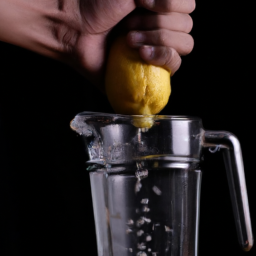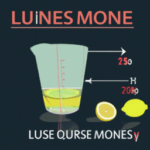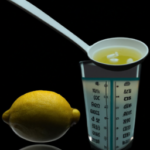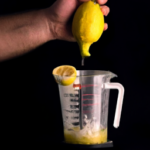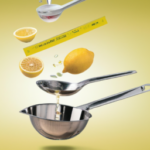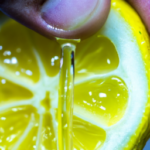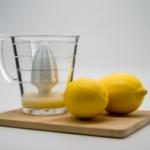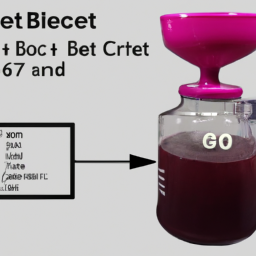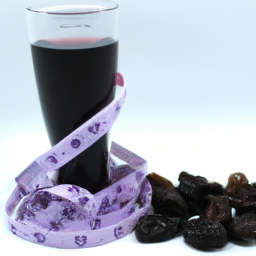As someone who loves to cook and bake, I often rely on the zest of a lemon to add a pop of flavor to my dishes. But have you ever stopped to think about just how much juice is packed into one lemon?
It’s a question that I’ve asked myself countless times, and one that I was determined to find the answer to. After doing some research and conducting my own experiments, I’ve discovered that the amount of juice in one lemon can vary depending on a number of factors.
From the anatomy of the lemon to the way it’s stored, there are a variety of factors that can affect how much juice you can extract from this versatile fruit. In this article, I’ll explore these factors in depth, as well as provide tips and tricks for getting the most juice out of your lemons.
So, if you’re ready to learn everything you ever wanted to know about how much juice is in one lemon, let’s get started!
Key Takeaways
- The amount of juice in a lemon can be affected by factors such as ripeness, size, and age.
- Rolling a lemon on a hard surface or microwaving it can help release more juice.
- Using a citrus juicer or reaming tool can maximize juice extraction.
- On average, one lemon yields around 2-3 tablespoons of juice.
Anatomy of a Lemon
Did you know that a lemon is made up of several parts, including the outer skin, pulp, and seeds?
The outer skin, or zest, is the colorful part of the lemon that’s often used for flavoring in recipes.
The pulp is the fleshy part of the lemon that contains the juice and is typically used in cooking and baking.
The seeds, although small, are an important part of the lemon as they contain the potential to grow into a new lemon tree.
There are many different varieties of lemons, each with its own unique flavor and juice content.
Some popular varieties include Meyer lemons, Eureka lemons, and Lisbon lemons.
When it comes to extracting lemon juice, there are a variety of tools and techniques that can be used, such as using a citrus reamer or juicer.
Lemon juice is a versatile ingredient that can be used in a variety of recipes, from savory to sweet.
However, the amount of juice that can be extracted from a single lemon can vary depending on several factors.
Factors Affecting Juice Content
The amount of liquid extracted from a citrus fruit can vary based on factors such as ripeness, size, and age. When it comes to juice extraction, fruit ripeness is one of the most important factors to consider. A ripe lemon will have a higher juice content compared to an unripe one because ripening increases the fruit’s water content, making it more plump and juicy.
Apart from ripeness, the size of the fruit can also affect its juice content. Larger fruits may contain more juice, but they may also be less flavorful compared to smaller fruits. Additionally, the age of the fruit can also play a role in juice extraction. As the fruit ages, it may become drier, resulting in a lower juice yield.
With these factors in mind, it’s important to choose ripe and plump fruits for optimum juice extraction. Speaking of yield, let’s now explore the average juice yield for a single lemon.
Average Juice Yield
When juicing a lemon, you can expect to yield an average amount of juice. Juice extraction can be affected by various factors such as the age of the fruit, its ripeness, and the type of juicer used. However, an average lemon can yield about 2-3 tablespoons of juice.
Measuring acidity is also another factor that can influence the amount of juice extracted from a lemon. The juice content can vary based on the pH level of the fruit. Generally, lemons with higher acidity levels tend to yield more juice. To maximize juice yield, it’s recommended to choose ripe and plump lemons with smooth skin, as they tend to have the highest juice content.
To get more juice out of a lemon, there are a few steps you can take. By rolling the lemon on a hard surface before cutting it, you can help break down the membranes inside and release more juice. You can also try microwaving the lemon for a few seconds or soaking it in warm water to help soften the fruit and make it easier to extract the juice. Additionally, using a citrus juicer or reaming tool can help you get the most juice out of your lemon.
How to Get More Juice Out of a Lemon
To maximize your lemon’s juice yield, there are a few tips and tricks you can try. First, roll your lemon on a hard surface to break down the lemon’s internal structure and soften it up. This will make it easier to extract more juice.
Alternatively, you can soak your lemon in warm water for a few minutes before juicing it. This will help to loosen up the pulp, making it easier to squeeze out every last drop of juice.
Another way to increase your lemon juice yield is to invest in a lemon squeezer or hand juicer. These tools make it easier to extract juice from lemons without having to use your hands. When using a squeezer or juicer, be sure to cut your lemons in half and place them cut-side down in the tool. Then, simply squeeze the handles together to extract the juice.
With these tips, you can get the most out of your lemons and enjoy their tangy goodness in all of your favorite recipes.
When it comes to buying and storing lemons, there are a few things to keep in mind. Look for lemons that are firm, smooth, and heavy for their size. Avoid lemons that have soft spots or blemishes, as these can indicate that the fruit is past its prime.
To store your lemons, keep them in a cool, dry place away from direct sunlight. You can also store them in the refrigerator, but be sure to use them within a week or two for maximum freshness and flavor.
Tips for Buying and Storing Lemons
For optimal flavor and shelf life, it’s important to choose firm, smooth, and heavy lemons when purchasing and store them in a cool, dry place or refrigerator. Avoid lemons with soft spots, bruises, or wrinkled skin, as these may indicate that the fruit is already dry and losing its flavor.
Additionally, it’s a good idea to look for lemons with thin, smooth skin and a bright, shiny color, as these are signs of freshness.
When it comes to using lemons in your best recipes, having a well-stocked supply is essential. To prolong the shelf life of your lemons, store them in a plastic bag in the crisper drawer of your refrigerator or in a cool, dry place away from direct sunlight.
If you don’t have fresh lemons on hand, there are several lemon juice substitutes you can use, such as bottled lemon juice, lime juice, or vinegar, although these may alter the flavor of your dish.
Lemon Juice Substitutes
When I don’t have fresh lemons on hand, I like to use other citrus fruits as a substitute. Lime and orange juice can be used in place of lemon juice in most recipes.
Another option is vinegar, which can add a similar acidic flavor to dishes.
Lastly, cream of tartar can be used in small amounts as a substitute for lemon juice in recipes that call for it as a leavening agent.
Other Citrus Fruits
You’ll be pleasantly surprised to know that other citrus fruits, such as oranges and grapefruits, can also provide a delicious and refreshing burst of flavor in your recipes. These citrus varieties are not only tasty, but also offer high nutritional value. Oranges are a great source of vitamin C, folate, and potassium, while grapefruits are rich in vitamin A and antioxidants.
To illustrate the nutritional value of these citrus fruits, here is a table comparing the vitamin C content of different citrus fruits based on a 100-gram serving:
| Citrus Fruit | Vitamin C (mg) |
|---|---|
| Lemon | 53.0 |
| Orange | 53.2 |
| Grapefruit | 31.2 |
As you can see, while lemons and oranges have similar vitamin C content, grapefruits have significantly less. However, grapefruits make up for it with their high levels of vitamin A and antioxidants, making them a great addition to any diet.
Moving on to the next topic, vinegar is another great ingredient that can add a unique and tangy flavor to your dishes.
Vinegar
Vinegar is an absolute game-changer in the kitchen, adding a tangy kick to any dish that’ll have your taste buds dancing with joy. While it may not be a direct substitute for lemon juice, vinegar can be used in recipes that require a sour or acidic component.
It’s important to note that vinegar has a much stronger flavor profile than lemon juice, so it should be used sparingly and with caution. However, combining vinegar and lemon juice in recipes can have its benefits. The two ingredients work together to enhance the overall flavor of a dish, while also adding a complex acidity that can’t be achieved with just one ingredient alone.
So, if you’re looking to switch things up in the kitchen or don’t have any lemons on hand, consider reaching for a bottle of vinegar instead. Cream of tartar is another common ingredient that can be used as a substitute for lemon juice, offering a similar acidic tang.
Cream of Tartar
If you’re in a pinch and need a substitute for acidic ingredients, cream of tartar can be a great option. This powdery substance is actually a byproduct of wine making and has a tangy, acidic taste.
Here are three ways you can use cream of tartar in baking:
-
Stabilize whipped cream: Adding a pinch of cream of tartar to your whipped cream can help keep it stable for longer periods of time. This is especially useful if you’re making desserts that need to be refrigerated for a few hours before serving.
-
Activate baking soda: If you don’t have any baking powder on hand, you can use cream of tartar to activate baking soda instead. Simply mix 1/4 teaspoon of cream of tartar with 1/2 teaspoon of baking soda to use in place of 1 teaspoon of baking powder.
-
Prevent sugar crystallization: When making syrups or candies, adding a small amount of cream of tartar can prevent sugar from crystallizing. This is because cream of tartar breaks down the sucrose molecules in sugar, making it less likely to form crystals.
The benefits of cream of tartar in cooking don’t stop at baking. It can also be used to clean copper pots and pans, as well as remove stains from fabric. However, when it comes to culinary uses for lemon juice, there’s a lot more to explore.
Culinary Uses for Lemon Juice
As a chef, I find lemon juice to be a versatile ingredient in both cooking and baking. Its acidic properties can be used to enhance the flavor of meats, fish, and vegetables.
Additionally, lemon juice can be found in many beverages, such as lemonade and cocktails, providing a refreshing and tart taste. It’s also a popular ingredient in salad dressings and sauces, adding a bright and tangy flavor to any dish.
Cooking and Baking
When you’re baking or cooking, you may wonder how much lemon juice is in one lemon. The answer is that it varies depending on the size and ripeness of the lemon. On average, one medium-sized lemon contains about 2-3 tablespoons of juice. However, it’s always best to juice the lemon and measure it out to get an exact amount for your recipe.
In addition to its culinary uses, lemon juice has many other practical applications. It can be used in skincare as a natural remedy for acne, dark spots, and oily skin. It also has cleaning properties and can be used as a natural, non-toxic cleaner for surfaces such as countertops and cutting boards.
When it comes to beverages, lemon juice is a popular ingredient in cocktails, teas, and lemonade. Whether you’re using it for cooking or other purposes, it’s important to remember that one lemon may not always yield the same amount of juice, so it’s best to measure it out.
Beverages
Sipping on a cool glass of lemonade is like taking a refreshing plunge into a pool on a hot summer day. As someone who loves to experiment with beverage recipes, I often use lemon juice in my concoctions. However, it’s important to know how much lemon juice is in one lemon to ensure the perfect balance of tartness and sweetness.
When making lemonade, I typically use about 4-6 lemons for every 1 cup of lemon juice. This ratio may vary depending on personal preference and the size of the lemons. Lemonade stands often use a simple syrup made from sugar and water to sweeten their lemonade, but using fresh lemon juice is key to achieving that perfect balance of flavors.
Now, let’s move on to discussing the use of lemon juice in salad dressings and sauces.
Salad Dressings and Sauces
After learning about the amount of lemon juice in various beverages, let’s move on to another important use of lemon juice in the kitchen – salad dressings and sauces. As someone who enjoys cooking and experimenting with different flavors, I’ve found that lemon juice is an essential ingredient in many dressings and sauces.
Not only does it add a tangy flavor, but it also helps to balance out other ingredients and enhance the overall taste. If you’re looking for some creative recipe ideas, using lemon juice in salad dressings and sauces is a great place to start.
Here are five different types of oils that you can pair with lemon juice to make a delicious dressing or sauce:
- Olive oil
- Avocado oil
- Sesame oil
- Walnut oil
- Coconut oil
Each oil has its own unique flavor profile, so pairing it with lemon juice can create a delicious and unique dressing or sauce. Additionally, using different types of oils can also provide various health benefits, such as increasing the good cholesterol in your body or aiding in digestion.
As we move on to the next section about the health benefits of lemon juice, it’s important to note that incorporating it into your diet through salad dressings and sauces is just one way to reap its benefits.
Health Benefits of Lemon Juice
You can reap numerous health benefits by adding a splash of lemon juice to your water or meals. Lemon juice is rich in vitamin C, which is essential for boosting the immune system and fighting off colds and flu.
Additionally, lemon juice has been shown to have detox benefits, as it helps flush out toxins from the body. This is due to the high levels of antioxidants present in lemon juice, which help to neutralize harmful free radicals in the body.
Not only does lemon juice have detox benefits, but it also has skin benefits. Lemon juice has natural astringent properties, which can help to tighten and tone the skin. It can also help to reduce the appearance of dark spots and blemishes, thanks to its ability to exfoliate and brighten the skin.
So next time you’re thinking about reaching for a sugary drink or processed snack, consider adding some lemon juice to your water or meal instead for a tasty and healthy boost.
When it comes to lemon juice, there are many myths and misconceptions out there. Some people believe that lemon juice can cure cancer or that it can help you lose weight overnight. However, it’s important to separate fact from fiction and rely on scientific evidence when it comes to the health benefits of lemon juice.
Let’s take a closer look at some of these myths and misconceptions in the next section.
Lemon Juice Myths and Misconceptions
Don’t let the sour rumors and false claims about this zesty fruit deter you from discovering the true health benefits of adding a squeeze of citrus to your daily routine. Lemon juice has been a popular ingredient in various dishes and drinks for centuries, and for good reason.
Contrary to popular belief, lemon juice is not as acidic as many people think. In fact, it falls on the lower end of the pH scale, with a pH level of 2, making it less acidic than vinegar and orange juice.
Another myth that needs to be debunked is the claim that lemon juice can aid in weight loss. While lemon juice alone cannot cause you to shed pounds, it can be a helpful addition to a healthy diet and exercise routine. Lemon juice contains pectin, a soluble fiber that can help you feel fuller for longer periods of time. Additionally, lemon juice can boost metabolism and aid in digestion, which can indirectly contribute to weight loss.
However, it is important to remember that lemon juice should not be relied on as a sole weight loss solution, and that a balanced diet and regular exercise are crucial components to achieving and maintaining a healthy weight.
Frequently Asked Questions
How does squeezing a lemon affect its nutritional value?
When a lemon is squeezed, it can affect its taste by releasing more juice and altering its acidity. However, squeezing can also result in some nutrient loss, particularly vitamin C, due to exposure to air and heat.
Can you use bottled lemon juice instead of fresh lemon juice in recipes?
Did you know that bottled lemon juice can have added preservatives and lack the same flavor as fresh lemon juice? However, it’s convenient and has a longer shelf life. For optimal freshness, store freshly squeezed lemon juice in an airtight container in the fridge.
Is it safe to drink lemon juice straight from the lemon?
Drinking lemon juice straight from the lemon is generally safe in moderation and can provide hydration and some benefits of lemon water, such as vitamin C and antioxidants. However, excessive consumption can harm tooth enamel.
Are there any precautions to take when using lemon juice on the skin?
As someone who values skin care, I take precautions when using lemon juice. Although it offers benefits for hair care, it can be harsh on the skin. Diluting it and avoiding sun exposure can help prevent irritation and discoloration.
How long does it take for a lemon to produce juice after being squeezed?
I’ve found that the optimal squeezing technique for a lemon involves rolling it on a hard surface before cutting it in half. From there, juice extraction time can vary but generally takes anywhere from a few seconds to a minute.
Conclusion
In conclusion, knowing how much lemon juice is in one lemon can greatly benefit anyone who loves to cook or enjoys drinking lemon water.
After researching the anatomy of a lemon and the factors that affect juice content, the average juice yield of one lemon is approximately 2-3 tablespoons. However, it’s important to note that this can vary depending on the size and ripeness of the lemon.
One interesting statistic to consider is that the United States is the world’s largest producer of lemons, with California being the top state for production. This highlights the importance of the lemon industry and the impact it has on the economy.
Additionally, the health benefits of lemon juice, such as its high vitamin C content and ability to aid in digestion, make it a valuable addition to any diet.
Overall, understanding the amount of lemon juice in one lemon can lead to better meal planning and a greater appreciation for this versatile fruit.
Ilana has been a vegan for over 10 years. She originally made the switch for health reasons, but soon found herself becoming more and more passionate about the ethical and environmental implications of a vegan lifestyle. Ilana is the author of The Graceful Kitchen, a blog all about veganism. She loves to cook up delicious and nutritious vegan meals, and share her recipes with others who are interested in leading a cruelty-free life. Ilana is also a strong advocate for using whole foods as the foundation of a healthy diet, and believes that going vegan is one of the best ways to achieve this.
